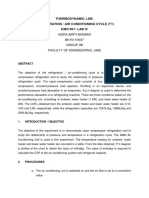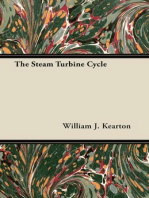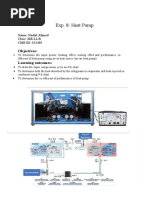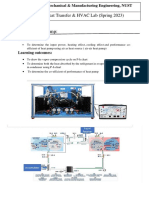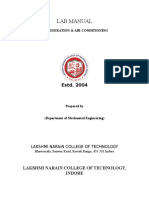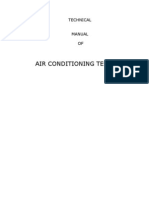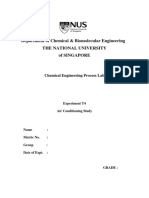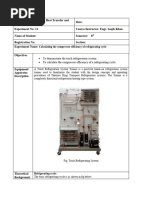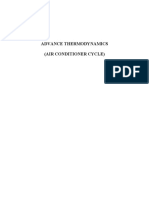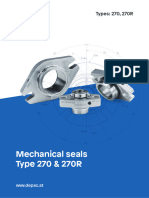Lab 8
Lab 8
Uploaded by
huzaifa zainCopyright:
Available Formats
Lab 8
Lab 8
Uploaded by
huzaifa zainOriginal Description:
Copyright
Available Formats
Share this document
Did you find this document useful?
Is this content inappropriate?
Copyright:
Available Formats
Lab 8
Lab 8
Uploaded by
huzaifa zainCopyright:
Available Formats
School of Mechanical & Manufacturing Engineering, NUST
ME-332 Heat Transfer & HVAC Lab (Spring 2023)
Name: Huzaifa Zain
Class: ME-12 (A)
CMS ID: 348419
Exp. 8: Heat Pump:
Objectives:
• To determine the input power, heating effect, cooling effect and performance co-
efficient of heat pump using air as heat source ( air-air heat pump)
Learning outcomes:
• To draw the vapor compression cycle on P-h chart
• To determine both the heat absorbed by the refrigerant in evaporator and heat
rejected in condenser using P-h chart
• To determine the co-efficient of performance of heat pump
School of Mechanical & Manufacturing Engineering, NUST
ME-332 Heat Transfer & HVAC Lab (Spring 2023)
Name: Huzaifa Zain
Class: ME-12 (A)
CMS ID: 348419
Procedure:
• Switch on the main power supply
• Switch on the power button (red on control panel)
• Configure the valves in such a way that both air evaporator and air condenser can be used for
performing the experiment.
• Switch on both the fans and adjust the rotational control knobs to set the speed of both the
fans. Set the condenser fan at full speed for better heat rejection in condenser
• Switch on the compressor and leave the compressor to run for a while so that a steady state
condition is reached in the system. A steady state is evident from the fact that the temperature
at the outlet of the compressor T1 stops rising.
• Record the refrigerant temperatures from T1to T4, and air temperatures from T8 to T10 and
also read the pressures from four gauges.
• On reading the pressure from pressure gauges 1 bar must be added to the value read to obtain
the actual pressure.
• Turn the compressor off.
• Calculate the cooling effect, C.O.P of heat pump and refrigerator, heat rejection by
refrigerator in condenser and draw the process in 𝑃 − ℎ chart making suitable assumptions
NOTE: MAKE SURE TO TURN OFF THE COMPRESSOR, FANS AND POWER SWITCH ON
THE CONTROL PANEL BEFORE CLOSING THE MAIN POWER SUPPLY AFTER
PERFORMING THE EXPERIMENT.
Data Recording (3):
Table 1:
Temperature Sensor Reading (in degree Celsius) Enthalpies h (kg/kJ)
S-T1 (Compressor Out) 61
h2 = 289.66
S-T2 (Condenser Out) 40 h3 = 108.28
S-T3 (Evaporator In) 10 h4 = 108.28
S-T4 (Evaporator Out) 10
h1 = 256.22
S-T8 (Air in condenser &
22
Evaporator)
S-T9 (Air Out Condenser) 34
S-T10 (Air out Evaporator) 17
School of Mechanical & Manufacturing Engineering, NUST
ME-332 Heat Transfer & HVAC Lab (Spring 2023)
Name: Huzaifa Zain
Class: ME-12 (A)
CMS ID: 348419
Table 2:
Refrigerant flow rate 35 L/hour = 9.72 x 10−6 m3 /𝑠
Pressure after Condenser 188 psi = 1296 kPa
Pressure after Expansion 62 psi = 427 kPa
Pressure after Evaporator 61 psi = 421 kPa
Pressure after Compressor 190 psi = 1310 kPa
Table 3:
Identifiers Value
compressor power SW-1 881 W
air inlet temperature to evaporator ST-8 25 ℃
air outlet temperature to evaporator ST-10 17 ℃
air Inlet temperature to Condenser ST-8 22 ℃
air outlet temperature to Condenser ST-9 34 ℃
C.O.P used as Heat Pump 5.46
C.O.P used as refrigerator 4.44
Tasks:
Q no 1: Draw the process on P-h chart (R-134a).
School of Mechanical & Manufacturing Engineering, NUST
ME-332 Heat Transfer & HVAC Lab (Spring 2023)
Name: Huzaifa Zain
Class: ME-12 (A)
CMS ID: 348419
Q no 2: From P-h chart determine the heat absorbed and heat released by the refrigerant in
evaporator and condenser.
𝑳 𝒎𝟑
Refrigerant flow rate = 𝟑𝟓 𝒉 = 𝟗. 𝟕 × 𝟏𝟎−𝟔 𝒔
𝒌𝒈
Mass flow rate = 𝟗. 𝟕 × 𝟏𝟎−𝟔 × 𝟏𝟐𝟎𝟕 = 𝟎. 𝟎𝟏𝟏𝟕𝟑 𝒔
𝑸̇𝑳 = 𝒎̇(𝒉𝟏 − 𝒉𝟒 ) = 𝟎. 𝟎𝟏𝟏𝟕𝟑 × (𝟐𝟓𝟔. 𝟐𝟐 − 𝟏𝟎𝟖. 𝟐𝟖) = 𝟏. 𝟕𝟑𝒌𝑾
𝑸̇𝑯 = 𝒎̇(𝒉𝟐 − 𝒉𝟑 ) = 𝟎. 𝟎𝟏𝟏𝟕𝟑 × (𝟐𝟖𝟗. 𝟔𝟔 − 𝟏𝟎𝟖. 𝟐𝟖) = 𝟐. 𝟏𝟑𝒌𝑾
Q no 3: Determine the power input from the P-h chart.
𝑾̇𝒊𝒏 = 𝒎̇(𝒉𝟐 − 𝒉𝟏 ) = 𝟎. 𝟎𝟏𝟏𝟕𝟑 × (𝟐𝟖𝟗. 𝟔𝟔 − 𝟐𝟓𝟔. 𝟐𝟐)
𝑾̇𝒊𝒏 = 𝟎. 𝟑𝟗𝒌𝑾
Q no 4: Using heat values from Q no 2 and power input from Q no 3 determine the COP of heat pump
and refrigerator.
𝑸̇ 𝑳 𝟏. 𝟕𝟑
𝑪𝑶𝑷𝑳 = = = 𝟒. 𝟒𝟑𝟔
𝑾̇𝒊𝒏 𝟎. 𝟑𝟗
𝑸̇ 𝑯 𝟐. 𝟏𝟑
𝑪𝑶𝑷𝑳 = = = 𝟓. 𝟒𝟔𝟐
𝑾̇𝒊𝒏 𝟎. 𝟑𝟗
Q no 5: What do you conclude from the values of COPs in Q no 4?
The average coefficient of performance (COP) for the refrigeration in the Edibon system is between
4 and 4.5, which is quite close to the calculated value of 4.44. This shows that the system can remove
4.44 units of heat from the cold reservoir for every unit of work that is applied to it. A system with
such a high COP is extremely efficient, which is normally accomplished by using premium materials
and careful engineering. Similar to this, the heat pump in the system has a coefficient of performance
School of Mechanical & Manufacturing Engineering, NUST
ME-332 Heat Transfer & HVAC Lab (Spring 2023)
Name: Huzaifa Zain
Class: ME-12 (A)
CMS ID: 348419
(COP) of 5.46, which indicates that for every unit of effort, 5.46 units of heat are removed from the
refrigerant and added to the environment.
Higher COP values denote higher apparatus efficiency, whereas lower values denote lower apparatus
efficiency.
Therefore, it is essential to keep the system maintained properly, which includes, among other things,
performing routine coil and filter cleaning.
You might also like
- Lab Report Air ConditioningDocument5 pagesLab Report Air ConditioningAzira Misman44% (9)
- Heat Pump Lab SheetDocument5 pagesHeat Pump Lab SheetLegendaryNNo ratings yet
- Optic Fiber ConnectorsDocument44 pagesOptic Fiber ConnectorsAntariksha Singh67% (3)
- Lab 8Document4 pagesLab 8Nashit AhmedNo ratings yet
- Lab Report 7 1Document6 pagesLab Report 7 1z06585964No ratings yet
- Lab 8Document3 pagesLab 8AhmedNo ratings yet
- ME - 4221 - Lab Manual - Exp - 01 - 02Document12 pagesME - 4221 - Lab Manual - Exp - 01 - 02Apurbo SahaNo ratings yet
- 803 Rac (Me-803) Exp. ManualDocument47 pages803 Rac (Me-803) Exp. ManualAnonymous z3RsdPToNo ratings yet
- Zakho University Mechanical Eng. Dept. 2 Year 2018-2019 Mechanical Lab/ Refrigeration and ACDocument7 pagesZakho University Mechanical Eng. Dept. 2 Year 2018-2019 Mechanical Lab/ Refrigeration and ACNorvinyeLorlortorYekoNo ratings yet
- RAC Experiments FinalDocument31 pagesRAC Experiments FinalEr Nikhil KakadeNo ratings yet
- Department of Mechanical Engineering. Mce315 Design Studies 1 Report On ExperimentDocument9 pagesDepartment of Mechanical Engineering. Mce315 Design Studies 1 Report On ExperimentBukky EmmanuelNo ratings yet
- Lab Refrigeration N Cooling TowerDocument21 pagesLab Refrigeration N Cooling TowerShahran IezzatNo ratings yet
- Lab 6Document6 pagesLab 6huzaifa zainNo ratings yet
- Air-Conditioning Test RigDocument10 pagesAir-Conditioning Test RigPankaj Thombare100% (1)
- T2. Air Conditioning StudyDocument8 pagesT2. Air Conditioning StudyHaha WoNgNo ratings yet
- Window - Air - Conditioning - Test - Rig Lab ManualDocument6 pagesWindow - Air - Conditioning - Test - Rig Lab ManualSandeep Saini100% (1)
- Experiment 12 (Coefficient of Performance COP)Document5 pagesExperiment 12 (Coefficient of Performance COP)Nouman NisarNo ratings yet
- 03. AIR REFRIGERATIONDocument13 pages03. AIR REFRIGERATIONDebashis DasNo ratings yet
- Lab 9Document5 pagesLab 9huzaifa zainNo ratings yet
- EXPERIMENT NO 4Document6 pagesEXPERIMENT NO 4mmaityssagarNo ratings yet
- RefrigerationDocument13 pagesRefrigerationSuvasish NathNo ratings yet
- Me2121-2 Performance Evaluation of Air-Conditioners (E1-03-01)Document11 pagesMe2121-2 Performance Evaluation of Air-Conditioners (E1-03-01)hybri8No ratings yet
- Lab Report 09 HVACDocument6 pagesLab Report 09 HVACMuhammad AsadNo ratings yet
- 16 Research PaperDocument7 pages16 Research Paperkhaja ziauddinNo ratings yet
- Modul Mke Refrigerasi Prof Amiral Aziz MSC APUDocument49 pagesModul Mke Refrigerasi Prof Amiral Aziz MSC APUDonie Widyanto SoedjarwoNo ratings yet
- T4 Air Conditioning StudyDocument10 pagesT4 Air Conditioning StudySzeQiLungNo ratings yet
- Experiment of Refrigeration and Air ConditioningDocument30 pagesExperiment of Refrigeration and Air ConditioningNitin Kumar100% (1)
- Experiment T4 For CN2108Document8 pagesExperiment T4 For CN2108Kiang Teng LimNo ratings yet
- Experiment No. 1Document4 pagesExperiment No. 1subhamgupta7495100% (1)
- Air Washer Test RigDocument5 pagesAir Washer Test RigJagdish Singh MehtaNo ratings yet
- Performance Analysis of Domestic Refrigeration Using Test RigDocument3 pagesPerformance Analysis of Domestic Refrigeration Using Test Rignutan BaradNo ratings yet
- CHAPTER 2 - AIR REFRIGERATION CYCLE (Compatibility Mode) PDFDocument12 pagesCHAPTER 2 - AIR REFRIGERATION CYCLE (Compatibility Mode) PDFVarun SinghNo ratings yet
- Refrigerator Test R1Document9 pagesRefrigerator Test R1GHyukendo Shaddiq AkhbarNo ratings yet
- AC Tutor1Document4 pagesAC Tutor1Jady chess24No ratings yet
- 2-2 Te-2 GTDocument10 pages2-2 Te-2 GTVamsi KrishnaNo ratings yet
- Lab Heat PumpDocument9 pagesLab Heat PumpShahran IezzatNo ratings yet
- Experiment 2 (2023) - 1Document7 pagesExperiment 2 (2023) - 1Hussein SaeedNo ratings yet
- Air Cycle Refrigeration Systems (Indian Institute of Technology Kharagpur)Document15 pagesAir Cycle Refrigeration Systems (Indian Institute of Technology Kharagpur)emawz21No ratings yet
- RefrigerationDocument163 pagesRefrigerationali105No ratings yet
- Experiment 11 (Compressoe Efficiency of A Refrigeration Cycle)Document5 pagesExperiment 11 (Compressoe Efficiency of A Refrigeration Cycle)Nouman NisarNo ratings yet
- Air Cycle Refrigeration SystemDocument30 pagesAir Cycle Refrigeration Systemtsegay100% (1)
- Lab Manual EBMV3103Document13 pagesLab Manual EBMV3103VOON KIN ONNNo ratings yet
- Performance of The Vapour Compression Cycle As A Refrigerator and As A Heat Pump 2Document8 pagesPerformance of The Vapour Compression Cycle As A Refrigerator and As A Heat Pump 2roneali098No ratings yet
- Refrigeration - Test - Rig Lab ManualDocument6 pagesRefrigeration - Test - Rig Lab ManualSandeep SainiNo ratings yet
- TABLE OF CONTENTS E123Document11 pagesTABLE OF CONTENTS E123MohitNo ratings yet
- To Understand Different Components of VCR System and To Determine Its COPDocument6 pagesTo Understand Different Components of VCR System and To Determine Its COPMohit MinzNo ratings yet
- Technological Institute of The Philippines: Determination of COP of A Refrigeration SystemDocument15 pagesTechnological Institute of The Philippines: Determination of COP of A Refrigeration SystemDessa GuditoNo ratings yet
- Experiment 1 (7th Semester)Document6 pagesExperiment 1 (7th Semester)Hussein SaeedNo ratings yet
- Refrigeration & Air Conditioning Lab (Mey-303) Experiment No. 3 Aim: To Evaluate The Performance of Domestic Air ConditionerDocument9 pagesRefrigeration & Air Conditioning Lab (Mey-303) Experiment No. 3 Aim: To Evaluate The Performance of Domestic Air ConditionerIshwarjit SinghNo ratings yet
- Exercise CompDocument6 pagesExercise CompatulsemiloNo ratings yet
- DiscussionDocument14 pagesDiscussionYousif OthmanNo ratings yet
- Refrigeration Comp. LinkedDocument6 pagesRefrigeration Comp. LinkedDin TescoNo ratings yet
- Effect of Inter-Stage Pressure On The Pe PDFDocument7 pagesEffect of Inter-Stage Pressure On The Pe PDFYADAV ANIL KUMARNo ratings yet
- Cop VCCDocument8 pagesCop VCCHussein SalahNo ratings yet
- Performance Analysis of 404a/508b Cascade Refrigeration Cycle For Low TemperatureDocument7 pagesPerformance Analysis of 404a/508b Cascade Refrigeration Cycle For Low TemperaturewbpeterNo ratings yet
- Dep 1122 Type 270 270r en Web 0Document13 pagesDep 1122 Type 270 270r en Web 0Pablo SauNo ratings yet
- CSM 3 - 4 - 5,5 - 7,5 HP: Otary Crew OmpressorDocument6 pagesCSM 3 - 4 - 5,5 - 7,5 HP: Otary Crew OmpressorVolodymуr VorobetsNo ratings yet
- ERStarPC PDFDocument7 pagesERStarPC PDFMahesaRivaldiNo ratings yet
- RUSSELDocument24 pagesRUSSELgabyNo ratings yet
- A Brief History of The ComputerDocument4 pagesA Brief History of The ComputerRandy MontesinoNo ratings yet
- Solerpalau Bathroom Exhaust BrochureDocument20 pagesSolerpalau Bathroom Exhaust BrochureirfanNo ratings yet
- Parts of A ComputerDocument45 pagesParts of A ComputerMarthe Del Rosario DeitaNo ratings yet
- Special Tools ListDocument13 pagesSpecial Tools ListNanang SuryanaNo ratings yet
- DIY Desk Series #9 - Fold-Down Wall DeskDocument8 pagesDIY Desk Series #9 - Fold-Down Wall DeskJeffrey WittyNo ratings yet
- 2116 Vem Spec 2015Document3 pages2116 Vem Spec 2015Aditya DikaNo ratings yet
- Owner'S Manual: Oven For Sublimation 20LDocument10 pagesOwner'S Manual: Oven For Sublimation 20LAhmadAlBadiNo ratings yet
- F mp201Document436 pagesF mp201serge525No ratings yet
- Ficha TecnicaDocument4 pagesFicha TecnicaAlexandre LopesNo ratings yet
- HP Zbook 15 G5 Mobile Workstation - Product End-of-Life Disassembly InstructionsDocument5 pagesHP Zbook 15 G5 Mobile Workstation - Product End-of-Life Disassembly InstructionscocoNo ratings yet
- Ordering Handbook.: Fagor Motors and DrivesDocument32 pagesOrdering Handbook.: Fagor Motors and DrivesRogério GarciaNo ratings yet
- Sis 2.0Document3 pagesSis 2.0fjhernandez_76No ratings yet
- Juno Lighting Price Book Trac-Master Distributor 6-76Document4 pagesJuno Lighting Price Book Trac-Master Distributor 6-76Alan MastersNo ratings yet
- Anti-Corrosives & Surface Modulars: Lenses & DiffusersDocument15 pagesAnti-Corrosives & Surface Modulars: Lenses & DiffusersLightingmaniaNo ratings yet
- Emas Ik If It CatalogueDocument6 pagesEmas Ik If It CatalogueGerardo Andres Cañaveral ArenasNo ratings yet
- TS 6300 DatasheetDocument3 pagesTS 6300 DatasheetRadu Dan NicolescuNo ratings yet
- 150.50 101580250101 101580250134 CabDocument7 pages150.50 101580250101 101580250134 Cabangga setyawanNo ratings yet
- Contacts CopyDocument1 pageContacts Copyyarperez9No ratings yet
- Aguas S.R.L.: Item # Item Number Description PriceDocument6 pagesAguas S.R.L.: Item # Item Number Description PriceGastón CortezNo ratings yet
- Evia Rods 2013Document69 pagesEvia Rods 2013Nuno RibasNo ratings yet
- Cable Installation Guidelines: CHECKFIRE 110/210 Detection and Actuation Systems (F-2016318)Document10 pagesCable Installation Guidelines: CHECKFIRE 110/210 Detection and Actuation Systems (F-2016318)claudio garciaNo ratings yet
- Service Manual 5800Document12 pagesService Manual 5800gwetheaNo ratings yet
- Jieyang Yongjiashun Cutlery ManufacturerDocument27 pagesJieyang Yongjiashun Cutlery ManufacturerNam TranNo ratings yet
- 0265-ABWFP-KNPC DRAWING NUMBER REQUEST - All DisciplineDocument5 pages0265-ABWFP-KNPC DRAWING NUMBER REQUEST - All DisciplineJeyakumarNo ratings yet
- Speed Control of DC Motor Using ChopperDocument16 pagesSpeed Control of DC Motor Using ChopperTejas MayekarNo ratings yet
